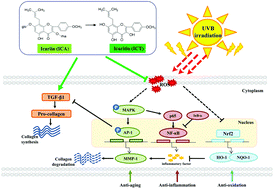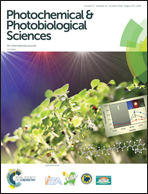Icariin and icaritin recover UVB-induced photoaging by stimulating Nrf2/ARE and reducing AP-1 and NF-κB signaling pathways: a comparative study on UVB-irradiated human keratinocytes
Abstract
Icariin (ICA) and icaritin (ICT) exhibit many pharmacological functions including anti-osteoporosis, anti-cardiovascular, and anti-cancer activities; however, there are few comprehensive studies that track the detailed effects on UVB-induced photoaging. The recovery effects of ICA and ICT were investigated in UVB-irradiated human keratinocytes (HaCaTs). The results indicated that ICT and ICA showed strong radical scavenging activity, and the reactive oxygen species (ROS) scavenging activity of ICT was superior. UVB-induced matrix metalloproteinase-1 (MMP-1) expression was blocked by ICA via the inhibition of mitogen-activated protein kinase/activator protein 1 (MAPK/AP-1), which directly reduced extracellular matrix (ECM) degradation. ICT activated nuclear factor erythroid 2 related factor 2 (Nrf2) to improve the anti-oxidative stress capacity and suppress nuclear factor-κB (NF-κB) activation, decreasing vascular endothelial growth factor (VEGF) protein, and inflammatory cytokines induced ECM degrading enzyme secretion. Moreover, ICT was more advantageous to improve transforming growth factor beta 1 (TGF-β1) and procollagen type I expression than ICA, promoting the synthesis of collagen. Therefore, ICA and ICT have potential to treat UVB-induced oxidative stress, inflammation and photoaging, and will be posited as a novel strategy to alleviate photodamage.



 Please wait while we load your content...
Please wait while we load your content...